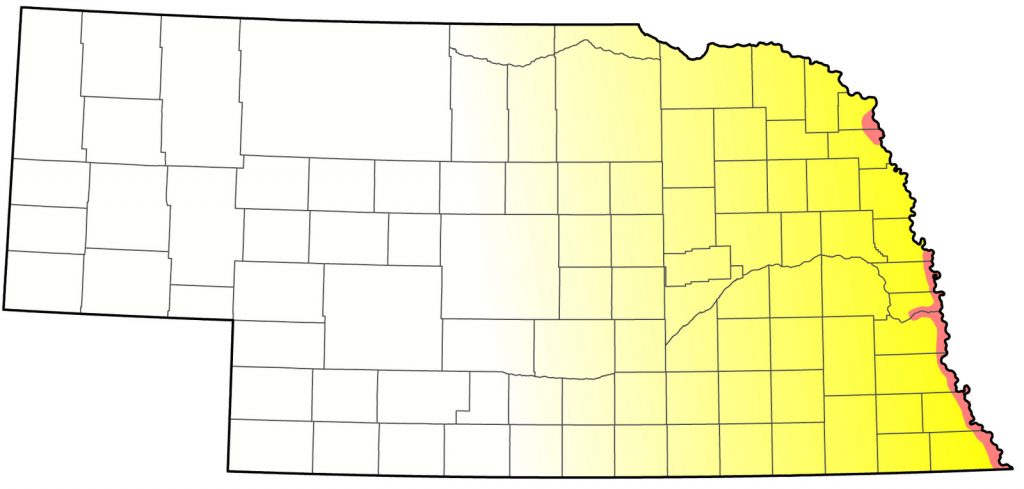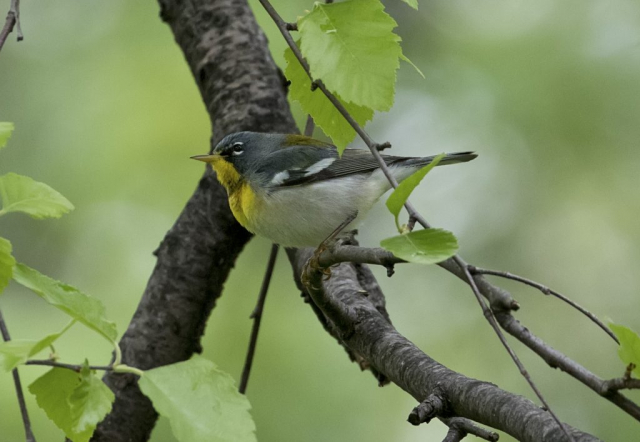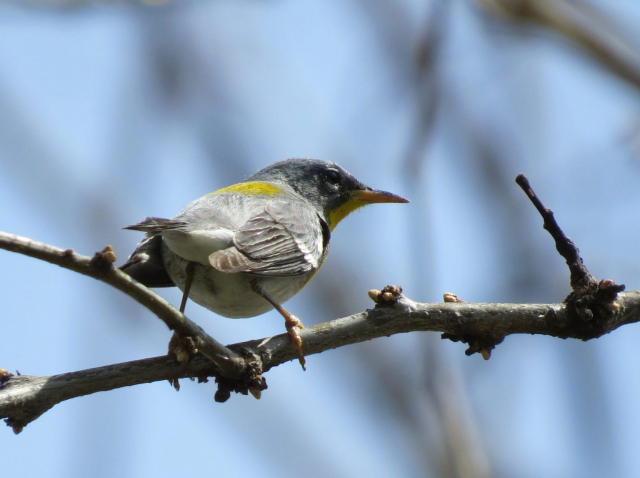Setophaga americana
Status: Fairly common regular spring migrant east, uncommon east-central, rare west-central, rare casual west. Uncommon regular breeder east. Uncommon regular fall migrant east, rare casual central and west.

Documentation: Specimen: UNSM ZM6817, 20 Apr 1901 Havelock, Lancaster Co.
Taxonomy: No subspecies are recognized (AviList 2025).
This species and Cerulean Warbler (S. cerulea) are closely related, with similar plumage, song, and behavior, have hybridized, and been considered conspecific (Moldenhauer and Regelski 2020). An Iowa example of a hybrid is at eBird Checklist – 13 May 2017 – Wildcat Den SP). There are no Nebraska records of this hybrid. See Comments, below.
Northern Parula also hybridizes on occasion with Yellow-throated Warbler (S. dominica); there are records for Wyoming and Iowa (eBird.org, accessed Jul 2023).
Spring: Apr 10, 11, 11 <<<>>> summer
Arrival is early, typical of the southern warbler species which breed in Nebraska. There appears to be a small movement up the Missouri River Valley in spring; Northern Parula is a rare migrant in eastern South Dakota (Tallman et al 2002).
There are about 20 reports in the Panhandle; these are in the period 21 Apr- 3 Jun.
- High counts: 20-25 at Fontenelle Forest, Sarpy Co 1 May 2008, 20 at Indian Cave SP, Nemaha and Richardson Cos 30 Apr 2011, 17 at Fontenelle Forest 23 Apr 2009, 17 there 29 Apr 2010, and 17 at Indian Cave SP 1 May 2015.
Summer: Northern Parula is a low-density summer resident in large forest tracts in the Missouri River Valley, north occasionally to Thurston Co; it occurs primarily in riparian forests, but uses a relatively broad range of woodland types for breeding (Moldenhauer and Regelski 2020) and often occurs in upland areas, especially at Indian Cave SP. Northern Parula has been reported regularly since the 1960s, mostly from southeast Washington Co south, although it was first reported as far north as Thurston Co 13 Jun 1998 and nested there in 2006, when a pair was incubating eggs 13 Jun (Huser, Probst; Mollhoff 2022). Its range extends west along the Platte River only to Schramm Park SRA, Sarpy Co, where there are several reports.
The few confirmed breeding records include young being fed in Sarpy Co in 1986 (Bennett 1987), 5 Sep 1991 (Grzybowski 1992) and 20 Aug 2004, and adults were tending a juvenile at Fontenelle Forest 28 Jun 2003 (Silcock 2003). Mollhoff (2016) showed breeding season reports in the Missouri River Valley in Richardson, Nemaha, Cass, Sarpy, Washington, and Thurston Cos 2006-2011. It was “quite common,” with up to six at Indian Cave SP, Richardson Co during Jun 1995.
BBS data 1966-2013 (Sauer et al 2017) show this species increasing in eastern Kansas and extreme southeast Nebraska at >1.5% per year.
Northern Parula is one of a few southeastern US wood warbler species for which reports are increasing northwest of the traditionally recognized ranges in Nebraska as field work explores new northwesterly locations with appropriate habitat, although this may also be an artifact of increasing observer activity since the inception of eBird. As long ago as 1919, it was described merely as an “uncommon migrant eastwardly” (Swenk 1919), but since then there have been several northerly breeding season reports. Short (1965) collected a singing male in Brown Co 21 June 1964, and it was reported there 12 Jun 1972 and 7 Jul 1968, but not in 1982 (Brogie and Mossman 1983). One was singing at Valentine, Cherry Co 4 Jul 1998 and another was nearby at Valentine NWR 11-12 Jul 2006. In 2021, 1-2 were at Fort Falls, Cherry Co through 23 Jun, and in 2023 one was recorded at Smith Falls SP, Cherry Co 5 Jun, possibly a migrant. A singing male was at Oak Valley WMA, Madison Co 10 Jun 2022.
Away from the Missouri River Valley locations, there are reports in the southeast in Gage, Jefferson, and Lancaster Cos. In Gage Co, reports are 30 Jun 2010 at Barneston and of 1-2 at two locations at Beatrice 8-29 Jun 2024. Singles were in Jefferson Co 3 Jun 2007 and at Fairbury City Park, Jefferson Co 5 Jun and 3 Jul 2021. One was recorded at 39th St in Lincoln, Lancaster Co 11 Jun 2022, and there have been consistent reports from the Wilderness Park location at 1st & Calvert St., Lancaster Co since 1999 (Moni Usasz, personal communication). A female and two males were photographed in the sycamore stand at the Epworth Park unit of WP in May 2025 and follow-up surveys for evidence of breeding at this site documented a singing male on territory there through 16 Jul who apparently bred successfully as a juvenile was recorded singing subsong during song learning from an adult male 20 Jun and and an immature male was photographed 4 Jul (Shari Schwartz, John Carlini, eBird.org). This appears to be the first breeding record for Lancaster Co, although the observers suggest that following May birds into Jul can be daunting and apparently no breeding season surveys of this sycamore stand were previously done. A second male on territory in June about 3/4 mi south singing from a sycamore on private property and abutting WP forest may have been the other male photographed in May.
The only summer records farther west are of a singing male at Chadron, Dawes Co 5 Jun 1979 (Rosche 1982), three in McCook, Red Willow Co 6 Jun (no year given), 10 Jun 2011 Chase Co, 17 Jun (female) and 29 Jun-1 Jul (singing male) at separate locations at Lakes McConaughy and Ogallala, Keith Co, and 26 Jun 2010 Ash Hollow SHP, Garden Co. Some of these reports, especially in early Jun, may be of migrants.
- Breeding phenology:
Eggs: 13 Jun
Nestlings: 27-28 May
Fledglings: 20 Jun-4 Jul
Fall: summer <<<>>> Oct 2, 2, 4; Sep 3, 4, 4 <<<>>> Oct 4, 7, 8 (away from breeding areas)
An earlier date away from breeding areas is 16 Aug 2022 Nance Co.
Later dates away from breeding areas are 14 Oct 2024 Valley Co, 17 Oct 2022 Kimball Co, 7 Nov 2021 Dundy Co, and 17 Nov 2023 Sarpy Co.
Northern Parulas become inconspicuous in late summer and fall, and depart by late Sep.
There are these few fall reports away from the east: 30 Jul-28 Aug 1977 Box Butte Reservoir, Dawes Co, 5 Sep 1979 Boone Co, 6 Sep 1998 male at Gering Cemetery, Scotts Bluff Co, 7 Sep 1912 specimen UNSM ZM11790 Thomas Co (Zimmer 1913), 12 Sep 1919 specimen UNSM ZM6840 Sioux Co, 20 Sep 2022 Scotts Bluff Co, 22 Sep 1997 Thomas Co, 26 Sep 2023 Scotts Bluff Co, 30 Sep 2014 Dawson Co, and 14 Oct 2024 Valley Co.
Occasionally very tardy individuals occur, oddly all in the west or west central: one at Gotte Park, Kimball Co 17 Oct 2022, one at Rock Creek SRA, Dundy Co 7 Nov 2021, an immature male photographed in Keith Co 4 Dec 1999 (Jorgensen 2001), and an apparent immature at Bridgeport, Morrill Co for about two weeks prior to 23 Dec 2023.
- High counts: 4 in Washington Co 11 Sep 1995, 4 in Washington and Douglas Cos 13 Sep 1998, and 4 on Plum Creek Trail, Seward Co 9 Sep 2018.
Comments: As Cerulean Warbler has declined in Nebraska in recent years, doubt has been raised by Justin Rink (personal communication) that heard only singers identified as Ceruleans at Indian Cave SP may in fact be Northern Parulas; all “odd” singers heard personally by Rink that might have been Ceruleans were tracked down and found to be Northern Parulas. Some or perhaps all of these “odd” songs may be an alternate Northern Parula song that Pieplow (2017) describes as a “second-category song”. This frequently heard two-part Northern Parula song consists of buzzy series of notes with the initial series lower in pitch than the succeeding series so sounds quite similar to a Cerulean’s song (Shari Schwartz; personal communication, eBird.org).
Images
Abbreviations
BBS: Breeding Bird Survey
NWR: National Wildlife Refuge
SHP: State Historical Park
SP: State Park
SRA: State Recreation Area
UNSM: University of Nebraska State Museum
WMA: Wildlife Management Area (state)
Literature Cited
AviList Core Team, 2025. AviList: The Global Avian Checklist, v2025. https://doi.org/10.2173/avilist.v2025.
Bennett, E.V. 1987. 1986 Nebraska nesting survey. NBR 55: 31-35.
Brogie, M.A., and M.J. Mossman. 1983. Spring and summer birds of the Niobrara Valley Preserve, Nebraska: An annotated checklist. NBR 51: 44-51.
Grzybowski, J.A. 1992. Southern Great Plains Region. American Birds 46: 113-117.
Jorgensen, J.G. 2001. 1999 (Eleventh) Report of the NOU Records Committee. NBR 69: 85-91.
Moldenhauer, R.R. and D.J. Regelski. 2020. Northern Parula (Setophaga americana), version 1.0. In Birds of the World (A. F. Poole, Editor). Cornell Lab of Ornithology, Ithaca, NY, USA. https://doi.org/10.2173/bow.norpar.01.
Mollhoff, W.J. 2016. The Second Nebraska Breeding Bird Atlas. Bull. Univ. Nebraska State Museum Vol 29. University of Nebraska State Museum, Lincoln, Nebraska, USA.
Mollhoff, W.J. 2022. Nest records of Nebraska birds. Nebraska Ornithologists’ Union Occasional Paper Number 9.
Pieplow, N. 2017. Peterson Field Guide to Bird Sounds of Eastern North America. Harper Collins.
Rosche, R.C. 1982. Birds of northwestern Nebraska and southwestern South Dakota, an annotated checklist. Cottonwood Press, Crawford, Nebraska, USA.
Sauer, J.R., D.K. Niven, J.E. Hines, D.J. Ziolkowski, Jr, K.L. Pardieck, J.E. Fallon, and W.A. Link. 2017. The North American Breeding Bird Survey, Results and Analysis 1966 – 2015 (Nebraska). Version 2.07. USGS Patuxent Wildlife Research Center, Laurel, Maryland, USA.
Short, L.L., Jr. 1965. Bird records from northern Nebraska during the breeding season. NBR 33: 2-5.
Silcock, W.R. 2003. Summer Field Report, June- July 2003. NBR 71: 106-127.
Swenk, M.H. 1919. The Birds and Mammals of Nebraska. Contributions of the Department of Entomology No. 23. Lincoln, Nebraska.
Tallman, D.A., Swanson, D.L., and J.S. Palmer. 2002. Birds of South Dakota. Midstates/Quality Quick Print, Aberdeen, South Dakota, USA.
Zimmer, J.T. 1913. Birds of the Thomas County Forest Preserve. Proceedings Nebraska Ornithologists’ Union 5: 51-104.
Recommended Citation
Silcock, W.R., and J.G. Jorgensen. 2025. Northern Parula (Icterus cucullatus). In Birds of Nebraska — Online. www.BirdsofNebraska.org
Birds of Nebraska – Online
Updated 11 Sep 2025


